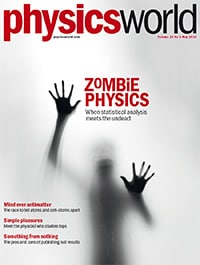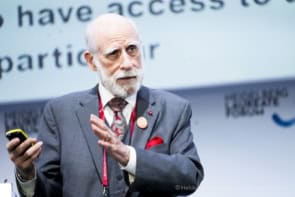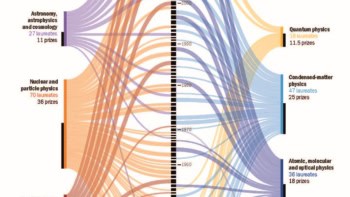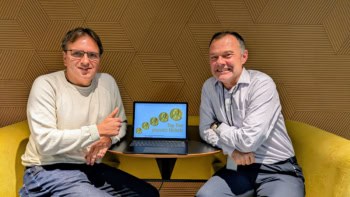 By Matin Durrani
By Matin Durrani
Physics stretches from the small to the large, from the simple to the complex and from low energy to high. It spans the entire alphabet too, with this month’s issue of Physics World including everything from the race to produce anti-atoms (A) at the CERN particle-physics lab near Geneva to a study of the physics of zombies (Z).
Zombies don’t exist, obviously. But we look at two physicists – Alex Alemi and Matt Bierbaum – who have studied the statistical physics of how zombies spread. As science writer Stephen Ornes explains, their interest emerged from a fun student project, but has led to a paper in a leading peer-reviewed journal and helped generate a wider appreciation of statistical physics.
If you’re a member of the Institute of Physics (IOP), you can now enjoy immediate access to the new issue with the digital edition of the magazine in your web browser or on any iOS or Android mobile device (just download the Physics World app from the App Store or Google Play). If you’re not yet in the IOP, you can join as an IOPimember for just £15, €20 or $25 a year to get full access to Physics World digital.
For the record, here’s a run-down of what else is in the issue.
· SLAC embarks on $1bn laser upgrade – An extremely bright free-electron laser at the SLAC National Accelerator Laboratory is designed to keep the US on a par with Europe in X-ray science, as Edwin Cartlidge reports
• China plots space ambitions – With China launching a batch of probes this year in the first part of its space priority programme, Cindy Hao discovers that funding issues may hit future missions
• Counting the cost – Can you quantify the benefits of building large physics facilities? Despite the uncertainties, Stefano Forte has done just that for CERN’s Large Hadron Collider
• Meet the topaholic – Robert P Crease meets Kenneth Brecher, who loves tops
• Zombie physics – What makes for a fun student project that provides useful results, a journal publication and a high-profile conference talk? Stephen Ornes describes how Alex Alemi and Matt Bierbaum spiced up their learning by mixing statistical physics with their love of zombie tales
• Stacking up 2D materials – Graphene might be the most famous example, but there are other 2D materials and compounds too. Louise Mayor explains how these atomically thin sheets can be layered together to create flexible “van der Waals heterostructures”, which could lead to a range of novel applications
• No result, no problem? – If you try to do an experiment or a calculation and it
doesn’t work out, should you tell other researchers about it? Or just move on to something more promising as quickly as you can? Philip Ball explores the pros and cons
of publicizing “null results” in science
• The anti-atom horse race – Do hydrogen and antihydrogen behave differently from each other? As Edwin Cartlidge reports, four groups of physicists housed inside a single building are vying to find out
• Riffing on the universe – Trevor Cox reviews The Jazz of Physics: the Secret Link
between Music and the Structure of the Universe by Stephon Alexander
• Cloudships in our future? – Ian Randall reviews The Planet Remade: How Geoengineering Could Change the World by Oliver Morton
• Light the way – The range of opportunities for physicists at science companies
is wider than one might expect, as Alyssa Armstrong discovered when she joined a laser research and manufacturing company
• Once a physicist – Rush Holt Jr is the chief executive officer of the American Association for the Advancement of Science, and was a member of the US House of Representatives from 1999 to 2015, representing New Jersey’s 12th Congressional District
• An elementary problem? – Geoff Vaughan wonders how many natural elements there are



